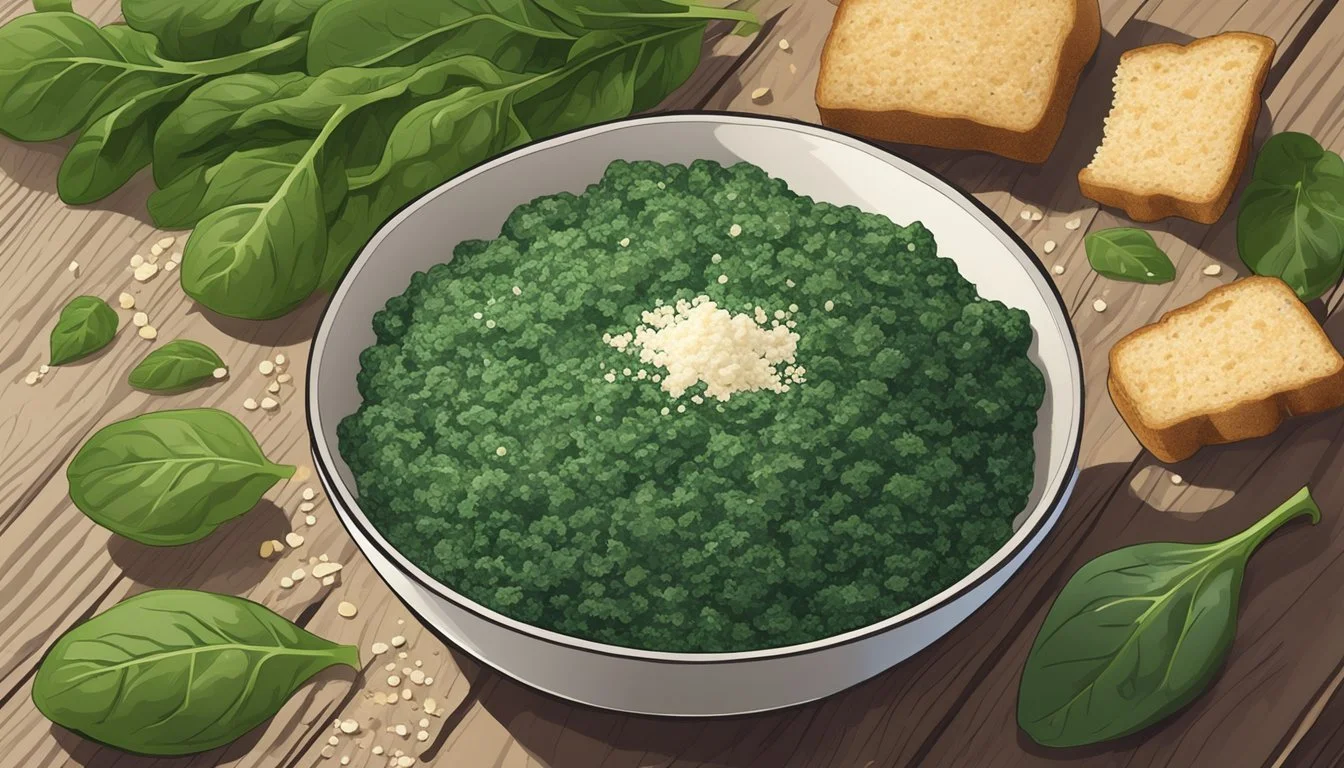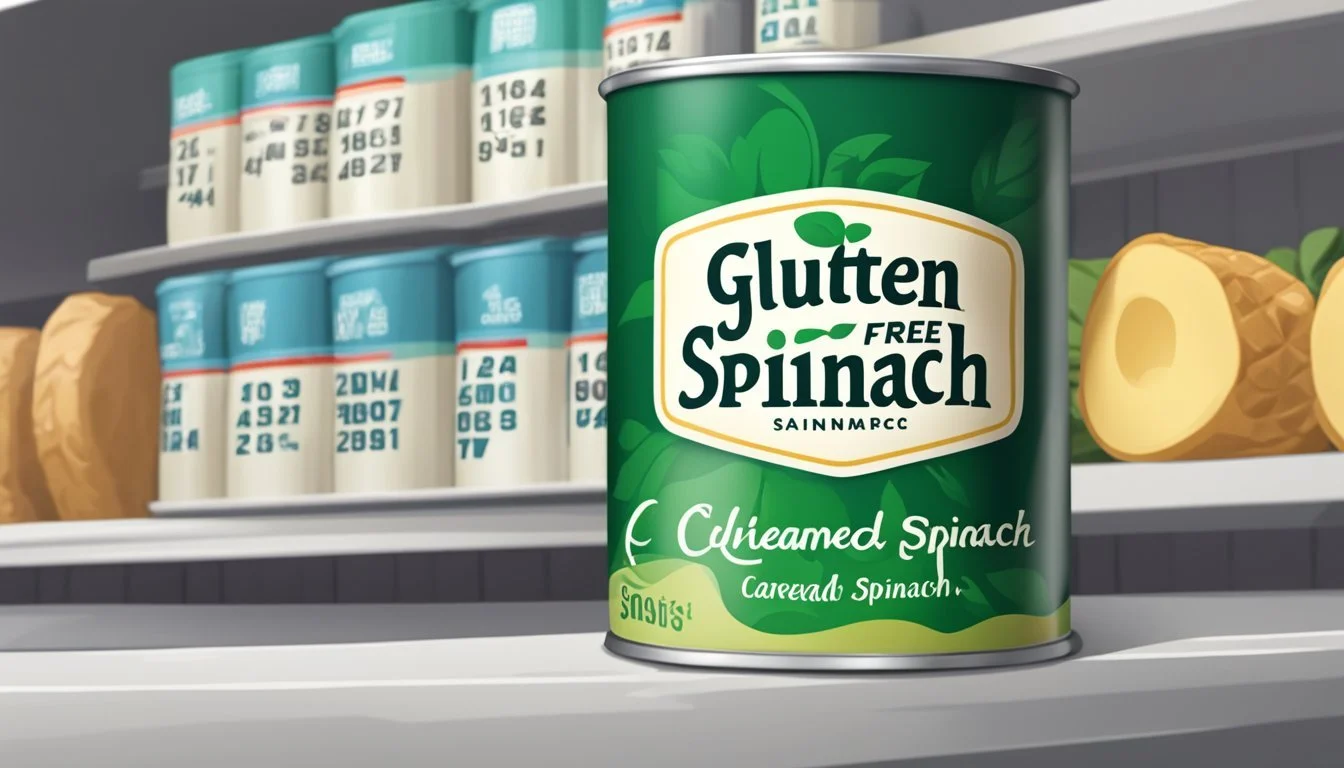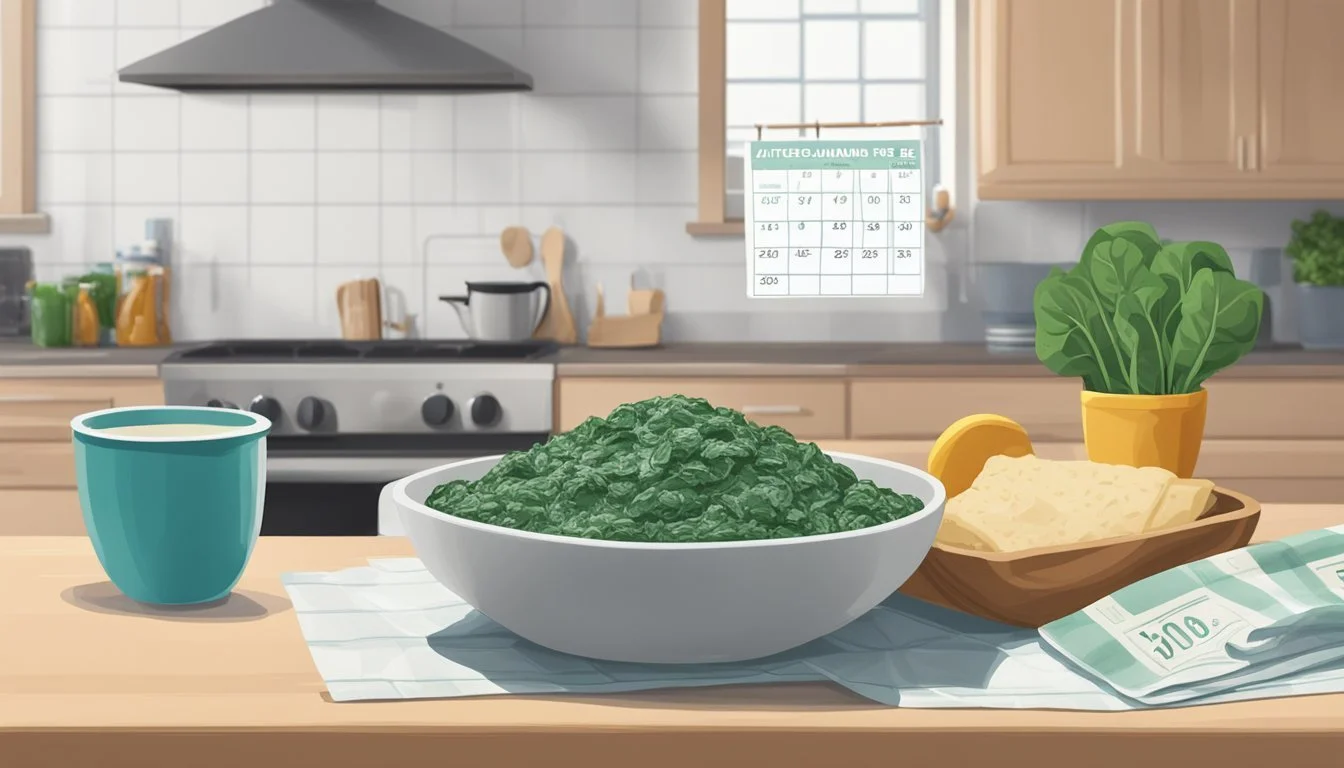How Long Does Gluten-Free Creamed Spinach Last?
Shelf Life and Storage Tips
Keto and gluten-free diets have become increasingly popular, and one delicious dish that fits perfectly within these parameters is gluten-free creamed spinach. When stored properly in a sealed container in the refrigerator, gluten-free creamed spinach can last for 3 to 4 days. This makes it a convenient and versatile side dish for those looking to maintain a healthy diet while still enjoying flavorful meals.
Gluten-free creamed spinach can be easily reheated either in the microwave or on the stovetop, making it a perfect option for meal prep. Whether used as a side dish for dinner or a quick, nutritious lunch, it retains its creamy texture and rich taste. The ability to store and reheat this dish without losing its quality adds immense value for anyone with a busy lifestyle.
Considering its simplicity and health benefits, gluten-free creamed spinach is a fantastic choice for anyone seeking to incorporate more green vegetables into their diet. By following a few basic storage steps, this dish remains a tasty and wholesome option throughout the week.
Understanding Gluten-Free Creamed Spinach
Gluten-free creamed spinach is a dish that caters to those avoiding gluten while retaining the rich and creamy texture of traditional recipes. It can be customized with various ingredients to meet dietary preferences like vegan or dairy-free.
Ingredients in Gluten-Free Creamed Spinach
Typical ingredients for gluten-free creamed spinach include spinach, butter (or dairy-free alternatives), and gluten-free all-purpose flour to thicken the sauce. Heavy cream or non-dairy milk substitutes are used to achieve the creamy texture. Seasonings like garlic, onions, salt, and pepper are added for flavor.
Spinach is the primary ingredient and can be fresh or frozen. Fresh spinach should be wilted and drained of excess liquid. When opting for vegan or dairy-free versions, substitute butter with vegan buttery spread and cream with plant-based milk like almond or soy milk.
Variations of Creamed Spinach
Creamed spinach recipes can be adapted to fit different dietary needs. Vegan creamed spinach uses vegan butter and dairy-free milk along with nutritional yeast for a cheesy flavor. For a lower-carb version, some recipes use low-carb bake mix instead of flour.
Additionally, you can find creative touches like adding red pepper flakes for a spicy kick or using shallots instead of onions for a more delicate flavor. These variations allow for flexibility to accommodate preferences while maintaining the essence of the dish.
Nutritional Profile
Gluten-free creamed spinach offers a wealth of nutritional benefits, making it a healthy addition to any diet. This section will highlight the key vitamins, minerals, and other nutritional content found in this dish.
Benefits of Gluten-Free Greens
Gluten-free creamed spinach is low in carbohydrates, which is ideal for those following a low-carb diet. Spinach itself is rich in vitamins A, C, and K, as well as iron and calcium. These nutrients support vision, immune function, and bone health.
Spinach is also packed with antioxidants, which help combat oxidative stress and may reduce the risk of chronic diseases. For those with gluten sensitivities, this dish provides a safe, nutritious option. Additionally, using alternative thickeners in place of wheat flour ensures the meal remains suitable for gluten-free diets.
Macro and Micro Nutrients
A serving of gluten-free creamed spinach typically contains around 100-150 calories, depending on the ingredients used. The macronutrient breakdown includes 4-6 grams of protein, 6-8 grams of fat, and 3-5 grams of carbohydrates. The fat content includes both healthy fats and small amounts of saturated fat, although careful ingredient selection can minimize this.
Fiber content is beneficial for digestion, providing about 2-3 grams per serving. This dish also supplies essential micronutrients: iron, potassium, magnesium, and calcium contribute to muscle function, bone strength, and overall metabolic processes. Spinach's high vitamin K content is crucial for blood clotting and bone health.
In many recipes, dairy-free alternatives are used, reducing cholesterol and saturated fats, making the dish healthier. Some versions include cauliflower sauce or nutritional yeast, which add extra vitamins and minerals, further enhancing the nutritional profile.
Storing Creamed Spinach
Proper storage of creamed spinach can extend its freshness and safety. Here are some detailed guidelines for refrigeration and freezing to ensure your dish remains delicious.
Refrigeration Guidelines
To store leftovers in the refrigerator, allow the creamed spinach to cool to room temperature first. Transfer it to an airtight container to maintain freshness and prevent odor absorption. Place the container in the refrigerator, where it can be safely stored for 3 to 4 days. This timeframe helps maintain the optimal flavor and texture of the spinach.
When ready to reheat, transfer the desired portion to a microwave-safe dish or a small saucepan. Heat on low to medium heat, stirring occasionally until warmed through. Maintaining gentle heat preserves the creamy consistency of the dish.
Freezing Instructions
Creamed spinach can also be frozen for longer storage. After cooling the spinach to room temperature, spoon it into freezer-safe containers or heavy-duty freezer bags. Leave some space at the top of the container as the spinach may expand when it freezes.
Label the containers with the date of freezing to keep track of its storage duration. The creamed spinach can be frozen for up to 3 months. When ready to use, thaw the spinach in the refrigerator overnight. Reheat gently on the stove or microwave, stirring frequently to maintain its creamy texture.
By following these steps, you can enjoy your gluten-free creamed spinach for an extended period without compromising on taste or safety.
Shelf Life Considerations
Shelf life for gluten-free creamed spinach depends on several factors including the quality of ingredients and storage practices. Proper storage and recognizing signs of spoilage are key to ensuring longevity and safety.
Determining Freshness
To determine the freshness of gluten-free creamed spinach, check for visual and olfactory indicators. Fresh creamed spinach should have a vibrant green color and a creamy consistency. Any discoloration, sliminess, or off smells could indicate spoilage.
Feel the texture as well. It should be smooth. A gritty texture may suggest contamination or degradation. If dairy products like yogurt, cream cheese, or sour cream are used, their expiration dates are critical. Using ingredients past their prime can shorten the dish’s shelf life.
Factors Affecting Longevity
Several factors can impact the longevity of gluten-free creamed spinach:
Storage Temperature: Maintain refrigeration at or below 40°F (4°C). Higher temperatures accelerate bacterial growth.
Ingredient Quality: Fresher spinach and dairy products, including alternatives like sour cream or cream cheese, help extend shelf life.
Container Integrity: Store creamed spinach in an airtight container to minimize exposure to air and contaminants.
Regularly stir and inspect the dish when stored for multiple days. Contaminants can be introduced through frequent opening and closing of the container, especially if not handled with clean utensils.
Preparation Tips
To make delicious gluten-free creamed spinach, it's crucial to master cooking techniques and achieve the right thickness. These methods ensure a flavorful, creamy dish that maintains its quality.
Creamed Spinach Cooking Techniques
For fresh spinach, rinse thoroughly and chop into smaller pieces. Baby spinach leaves are great for a tender texture. If using frozen spinach, thaw and drain excess water by squeezing with a towel.
Prepare a roux by melting butter and adding minced garlic. Sauté for about 1-2 minutes until aromatic. Add gluten-free flour to the butter and garlic, stirring constantly to cook the flour without browning it. This helps to create a smooth base.
Gradually whisk in liquid, like milk or cream, ensuring there are no lumps. Simmer, then fold in the spinach. Mix in cream cheese for richness. Parmesan or mozzarella cheese can be added for extra creaminess and flavor.
Making Creamed Spinach Thicker
To make creamed spinach thicker, there are several options. Increase flour in the roux slightly for a thicker consistency. Cooking the sauce longer can also help as some moisture evaporates.
Adding mashed cauliflower is another method; it blends seamlessly and gives a creamy texture. Pureed cauliflower can substitute part of the cream, providing a thicker feel without adding too many calories.
Another option is to use cream cheese, which naturally thickens the sauce while adding a tangy flavor. Cheeses like Parmesan or mozzarella can also thicken the sauce due to their high melting point, giving the dish a more complex taste.
Serving Suggestions
Gluten-free creamed spinach is versatile, making it an excellent companion to various dishes. It can be paired with main courses or enjoyed as a dip or spread for a more creative serving option.
Pairing with Main Courses
Gluten-free creamed spinach pairs well with several main courses, enhancing the flavor and texture of the meal. Chicken, whether it's roast chicken or grilled chicken breast, complements the creamy texture of the spinach. It also pairs excellently with steak. A grilled steak or roast beef benefits from the rich, buttery taste of the creamed spinach.
For those following a keto diet, creamed spinach is a delightful side dish that fits perfectly with meat-heavy meals. Additionally, it's a popular choice for special occasions like Thanksgiving, often served alongside turkey, ham, or other festive dishes.
Serving as a Dip or Spread
Gluten-free creamed spinach can be transformed into a delicious dip or spread. It serves as a tasty and nutritious option for parties or snacks. Pair it with gluten-free bread, crackers, or fresh vegetable sticks like celery and carrot for a refreshing appetizer.
It's also a great addition to a casserole. Mix it with roasted vegetables or chicken to create a comforting and satisfying meal. This versatile spread can also enhance the flavor of sandwiches and wraps, adding a creamy, rich texture without gluten.
These serving suggestions demonstrate the versatility and deliciousness of gluten-free creamed spinach, making it a valuable addition to any meal plan.
Modifications and Substitutions
This section covers variations in dairy and non-dairy options, and gluten-free thickening alternatives, important for customizing creamed spinach recipes to suit dietary preferences.
Dairy and Non-Dairy Options
For a traditional dairy-based creamed spinach, heavy whipping cream or cream cheese creates a rich texture. Some prefer Greek yogurt for a tangy twist, adding both creaminess and a slight acidity that enhances the flavor.
For those on a dairy-free or vegan diet, non-dairy substitutes are essential. Cashew milk and almond milk are popular for their mild flavors and creamy textures. Dairy-free cheeses, like those based on nut milks or soy, can be melted into the spinach for a similar mouthfeel. Vegan buttery spreads can replace traditional butter, maintaining richness without animal products.
Gluten-Free Thickening Alternatives
Ensuring the recipe remains gluten-free involves choosing appropriate thickening agents. Cornstarch is a common choice, blended with a small amount of cold water to create a slurry, then stirred into the hot spinach mixture to thicken.
Arrowroot powder or tapioca starch serves a similar purpose, and these can be used in the same way, ensuring the dish remains smooth and cohesive. Rice flour is another alternative, though it can sometimes impart a slight graininess.
These options make it possible to enjoy creamed spinach while adhering to a gluten-free diet, maintaining both texture and taste.
Health Considerations
Gluten-free creamed spinach offers dietary benefits and fulfills specific nutritional needs. This dish can support various health goals, including managing gluten intolerance and contributing to a balanced diet.
Impact on Diet and Well-being
Gluten-free creamed spinach can be a valuable addition to a low-carb or keto-friendly diet. Spinach is rich in fiber and low in carbs, making it an excellent choice for those monitoring their carbohydrate intake. Additionally, spinach is high in antioxidants, vitamins A, C, and K, which contribute to immune function and skin health.
The ingredients used, such as cashew milk or alternative flours, help maintain the dish's creamy texture without adding gluten. It is also beneficial for maintaining blood pressure due to its low sodium content when prepared with fresh ingredients and minimal salt.
The absence of gluten can help those with gluten sensitivities or celiac disease, preventing adverse reactions and promoting better digestive health. This dish aligns well with health-conscious eating habits while providing essential nutrients and energy.
Allergy and Intolerance Information
For those with allergies or intolerances, gluten-free creamed spinach can be adapted to suit various needs. Using gluten-free flour ensures that individuals with gluten intolerance or celiac disease can safely consume this dish. Additionally, those with dairy allergies can substitute traditional dairy products with plant-based alternatives like cashew or almond milk.
It is important to note that some recipes may include nuts, especially if cashew milk is used, which can trigger allergic reactions in individuals with nut allergies. Therefore, always check ingredient labels and opt for nut-free alternatives when necessary.
By carefully selecting ingredients, gluten-free creamed spinach can be made safe and enjoyable for people with various dietary restrictions, providing a nutritious and satisfying dish that accommodates their specific health needs.
Reheating and Serving Leftovers
Reheating gluten-free creamed spinach ensures the creamy sauce and rich flavors are preserved. It's essential to use proper methods to maintain texture and taste.
Best Methods to Reheat
Oven: Preheat the oven to 300°F (150°C). Place the creamed spinach in a shallow baking dish. Add 1-2 tablespoons of liquid such as milk, water, or cream to keep it moist. Cover tightly with foil and heat for 5-10 minutes, stirring halfway.
Microwave: Use a microwave-safe container. Heat on low power for about 1-2 minutes, stirring every 30 seconds. This prevents the creamy sauce from separating and ensures even heating.
Stovetop: Place the leftover spinach in a frying pan. Reheat on low heat, stirring frequently until warmed through. Adding a splash of liquid can help maintain the creamy consistency.
Maintaining Texture and Flavor
Room Temperature: Allow the dish to sit at room temperature for 10-15 minutes before reheating. This reduces thermal shock, helping retain a smooth texture in the creamy sauce.
Stirring: Stir the spinach halfway through reheating, especially in the oven or microwave. This ensures even heat distribution and prevents clumping.
Liquid: Adding a small amount of liquid, like milk or stock, before reheating keeps the spinach moist. It also helps maintain the creamy texture without becoming too thick or dry.
Serving: For extra flavor, top with grated cheese and bake until hot and bubbly. This not only adds a crispy topping but enhances the overall taste of the leftover creamed spinach.
These methods ensure that gluten-free creamed spinach remains delicious and satisfying as leftovers.











